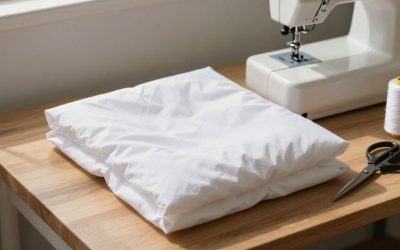When deciding between a pillow filled with synthetic or down material, it can be difficult to know which is best suited for you. Both synthetic and down materials offer advantages and disadvantages, so it’s important to know what each type of material has to offer before deciding. In this article, we’ll compare the two materials, highlighting the benefits and drawbacks, and then discuss some factors to consider when choosing between synthetic and down pillows.
Synthetic vs Down Pillows: A Comparison
Synthetic materials, such as polyester fibres, are made from synthetic fibres and non-allergenic materials, such as foam. Synthetic materials are cheaper to produce, more widely available and often more resilient than down. Synthetic materials can also offer support and comfort, however they don’t hold their shape as well as down and can flatten quickly.
Down pillows are made from the soft, fluffy undercoating of a bird, usually a duck or a goose. Down pillows are more expensive than synthetic pillows, but they are also more luxurious and comfortable. They are also more durable and can last for many years. Down pillows are also hypoallergenic, making them a great choice for people with allergies.
What is Synthetic Down?
Synthetic down is made from synthetic fibres, such as polyester. It’s hypoallergenic and created to mimic the softness and feel of a down pillow, while still providing support and comfort. Synthetic down pillows are generally more affordable than natural down pillows, and they’re easier to take care of, as they don’t need to be fluffed and adjusted as often.
Synthetic down is also more durable than natural down, and it’s less likely to lose its shape over time. It’s also more resistant to moisture, making it a great choice for people who live in humid climates. Additionally, synthetic down is often made from recycled materials, making it a more eco-friendly option.
Synthetic down pillows are available in a variety of shapes and sizes, so you can find one that fits your needs. They’re also available in a range of colors and patterns, so you can find one that matches your decor. Whether you’re looking for a pillow that’s soft and supportive, or one that’s more durable and eco-friendly, synthetic down is a great option.
Advantages of Synthetic Down Pillows
As mentioned, one of the main advantages of synthetic down pillows is their cost. They usually cost less than traditional down pillows, making them more accessible. In addition, synthetic down pillows can be more durable as they tend to hold their shape better and are less likely to flatten over time.
Another advantage of synthetic down pillows is that they are hypoallergenic, making them a great choice for people with allergies. They are also easier to clean and maintain than traditional down pillows, as they can be machine washed and dried. Synthetic down pillows are also more resistant to mold and mildew, making them a great choice for humid climates.
Disadvantages of Synthetic Down Pillows
The main disadvantage of synthetic down pillows is the lack of breathability. The synthetic materials don’t allow air to circulate between the fibres, making them less breathable than down materials. This can lead to overheating and an increased risk of developing skin irritation.
Synthetic down pillows are also not as durable as down pillows. The synthetic materials are more prone to wear and tear, and may need to be replaced more often than down pillows. Additionally, synthetic down pillows are not as comfortable as down pillows, as the synthetic materials are not as soft and plush.
Finally, synthetic down pillows are not as environmentally friendly as down pillows. The synthetic materials used to make them are not biodegradable, and can take a long time to break down in landfills. This can lead to an increased amount of waste in the environment.
What is Down?
Down is a natural material made from the fluffy bits of feathers from ducks or geese. It’s lightweight, breathable and provides excellent insulation, making it a popular choice for bedding products. Natural down pillows have been around for centuries, but modern-day versions usually have a synthetic outer shell to protect the feathers inside.
Down is a great choice for bedding because it is incredibly soft and comfortable. It is also very lightweight, making it easy to move around and store. Additionally, down is very breathable, which helps to keep you cool in the summer and warm in the winter. It is also very durable and can last for many years with proper care.
Advantages of Down Pillows
Down pillows offer a range of benefits including excellent breathability and temperature regulation. They are also lightweight and generally softer than synthetic pillows, providing good comfort and support. They are also less likely to flatten over time, making them a great option for people looking for lasting comfort.
Down pillows are also hypoallergenic, making them a great choice for people with allergies. Additionally, they are easy to clean and maintain, as they can be spot cleaned or dry cleaned. They are also more durable than synthetic pillows, so they can last for many years with proper care.
Disadvantages of Down Pillows
The main disadvantage of down pillows is their cost. Natural down pillows are typically more expensive than synthetic pillows, due to their increased quality. They can also require more maintenance, as they may need to be fluffed and adjusted periodically to keep them in good condition.
Down pillows can also be difficult to clean, as they can be damaged by washing machines and dryers. Spot cleaning is usually the best option for cleaning down pillows, as it is less likely to damage the material. Additionally, down pillows can be more prone to dust mites and other allergens, so they may not be the best choice for people with allergies.
Factors to Consider When Choosing Between Synthetic and Down Pillows
When choosing between synthetic and down pillows, it’s important to take into account your budget and personal preferences. If you prefer a softer pillow that is still supportive enough to provide adequate neck support, then a down pillow may be the best choice. On the other hand, if you’re looking for an affordable pillow that will offer lasting comfort and is less likely to flatten over time, then a synthetic pillow may be more suitable.
It is also important to consider the environmental impact of your choice. Down pillows are often made from feathers that are a by-product of the food industry, while synthetic pillows are usually made from synthetic materials that are not biodegradable. If you are looking for an eco-friendly option, then a synthetic pillow may be the better choice.
Tips for Caring for Synthetic and Down Pillows
It’s important to take care of both synthetic and down pillows to ensure they stay in good condition for longer. Synthetic pillows should be washed regularly with a mild detergent, while down pillows should be air-dried only. To maintain fluffiness, both types of pillows should be fluffed and adjusted periodically.
When it comes to deciding between synthetic and down pillows, it’s important to consider your budget, preferences and needs. Synthetic pillows are generally more affordable and easier to care for, while down pillows offer excellent breathability and temperature regulation. Ultimately, the decision comes down to personal preference, so be sure to consider all the factors before making a decision.
Synthetic pillows are often made from polyester or foam, and are usually machine-washable. They are also hypoallergenic, making them a great choice for those with allergies. Down pillows are usually made from feathers or a combination of feathers and down, and are usually dry-clean only. They are also more expensive than synthetic pillows, but offer superior comfort and support.
No matter which type of pillow you choose, it’s important to take good care of it. Regular washing and fluffing will help keep your pillow in good condition for longer. Additionally, it’s important to replace your pillow every two to three years to ensure you get the best sleep possible.



